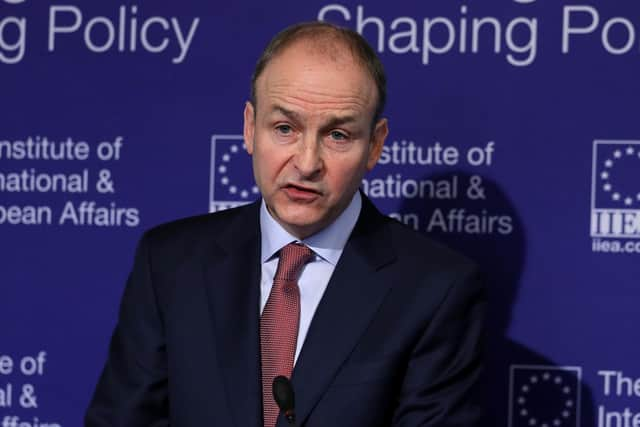Alex Kane: Idea of Sinn Fein in power in Dublin is not so fanciful


I also noted that it could be Sinn Fein which would be the primary beneficiary of a continuing fall in Fine Gael support, raising the possibility that, irrespective of what Micheál Martin and Leo Varadkar were saying in public, no one should dismiss the possibility of Mary Lou McDonald receiving a phone call on Monday February 10.
A recent slew of polls has seen Sinn Fein nudge consistently ahead of Fine Gael, while one in yesterday’s Business Post has the party neck and neck with Fianna Fáil. Ironically, that could yet help Micheál Martin, because it could push the anti-Sinn Fein vote (and it’s worth bearing in mind that it is still sitting at just 24%) behind his party as the best anti-Sinn Fein option. Or, it could embolden Sinn Fein voters.
Advertisement
Hide AdAdvertisement
Hide AdThe party does well in opinion polls with youngish working-class males, but they tend not to come out in sufficient numbers on the day. This time – believing that their vote might actually count and rattle the ‘establishment status quo’ – they might come out.


It was the equivalent of those voters who caused the Brexit and Trump ‘upsets’. The party could also pick up some votes that have tended to go to left-wing independents.
Sinn Fein isn’t running enough candidates to become the largest party (which may prove to be a major error in a PR election); but if what looks like a potential Fine Gael meltdown happens, then Sinn Fein could yet have a key role to play in the shape of the next government.
Eighty seats is required for a majority and the polls (and let’s never forget, of course, that the most recent polls could be wrong) suggest that no party will reach that target.
Advertisement
Hide AdAdvertisement
Hide AdMicheál Martin needs to add 36 seats to the 44 he won in 2016, but he is still sitting on the same percentage the party won four years ago. Sinn Fein, on the other hand, won 23 seats on a 14% share in 2016 and looks to be on course for a 10% increase next Saturday.
So, what happens if Martin finds himself 20 or so short of a majority and Sinn Fein has 30 + seats on offer? He has a number of options, depending how the Greens, smaller parties and independents do. But that sort of arrangement can be messy and require all sorts of competing and contradictory promises to get people on board.
He could, of course, talk to Fine Gael (and I’m presuming Varadkar would be forced to resign if there is a collapse), yet trying to cut a deal with a government you’ve just defeated is never easy.
Varadkar could try and do what Gordon Brown did in 2010 when he tried to cling on to power with the help of the Lib-Dems. But in the end the Lib-Dems rowed backed from the deal and cut one with David Cameron’s Conservatives – on the basis that Brown had actually lost the election and already been deprived of a mandate. For Sinn Fein, a deal with a party which has lost a mandate doesn’t really offer all that much.
Advertisement
Hide AdAdvertisement
Hide AdIt would probably make life easier for Martin if he were able to cut a deal with just one party and give himself a reasonably comfortable overall majority. Yet, as it stands right now, it looks like the only party capable of doing that deal would be Sinn Fein. Would he, could he, pull it off?
Fianna Fáil has been out of power for nine years. There’s a significant number of its TDs and key players who could live with Sinn Fein in coalition. Something resembling stability is better than a day-to-day survival (which is how David Cameron sold the Lib-Dem deal to his party). His calculation might be that he would get the most from a deal. It puts the keys to office in his hands and gives him the chance to rebuild his party in government. He may also find it easier to cut a deal now that Gerry Adams isn’t in the Dáil.
All of that said, a deal with Sinn Fein would still require a number of quid quo pro, some of which could be difficult for a right of centre party and its left-wing equivalent to agree on. Martin will be aware of the problem that David Cameron gave himself when he offered a referendum on EU membership in the hope of scuppering Ukip’s chances in the 2015 general election. But it’s worth noting that Fianna Fáil’s manifesto does contain a pledge to establish a team to lead a ‘formal study and cross-community consultation on a Green Paper to outline how the Irish government should approach handling a unity referendum should circumstances arise where it can be called’.
And it’s also worth noting that Mary Lou McDonald has already suggested 2025 as a possible date for a border poll, adding: “This needs to be a respectful conversation and it’s the job of the government in Dublin to shape that conversation. If we look to Britain, and lots of us have reflected on the disorder and chaos which has arisen because of a lack of planning and a fully informed debate on the issue of Brexit, we shouldn’t sleepwalk into a similar scenario. Brexit has accelerated this conversation. It’s reckless not to plan (and) to plan from now.”
Advertisement
Hide AdAdvertisement
Hide AdThe polls could be wrong and Sinn Fein could underperform. Fianna Fáil could do better than expected and find itself able to cut a deal with the Greens. There is still a very significant distrust of Sinn Fein within Ireland’s political establishment. Am I suggesting that a Fianna Fáil/Sinn Fein deal is inevitable? No. But I am suggesting that the possibility of such a deal might be greater than most observers think.